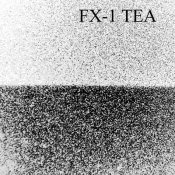Alan Johnson
Subscriber
- Joined
- Nov 16, 2004
- Messages
- 3,258
FX-1 is the highest acutance developer of all but with a pH about 11 it is a bit grainy.I replaced the carbonate B solution by dilute TEA giving a pH about 9.5.
A-Metol 5g, Sodium sulfite 50g, Water to 1L
B-TEA 200ml, water to 1L
For use take 1 part A, 1 part B, 8 parts water
Develop 4-5 times as long as D76 1+0 time, agitate 1 min then 30s every 8 min for 35mm, every 4 min for 120.
IMO high acutance developers show the effect best if printed slightly contrasty.
Attachments show positives from approx 1mm squares of APX-100 negative,photos of a black card on a gray card ,developed in FX-1 and FX-1 TEA.Adjacency effects can be seen.On prints from actual scenes, the grain is somewhat reduced with the TEA version.
Metol exhaustion may give highest acutance but the experiment shows patience is needed to go down this route.
A-Metol 5g, Sodium sulfite 50g, Water to 1L
B-TEA 200ml, water to 1L
For use take 1 part A, 1 part B, 8 parts water
Develop 4-5 times as long as D76 1+0 time, agitate 1 min then 30s every 8 min for 35mm, every 4 min for 120.
IMO high acutance developers show the effect best if printed slightly contrasty.
Attachments show positives from approx 1mm squares of APX-100 negative,photos of a black card on a gray card ,developed in FX-1 and FX-1 TEA.Adjacency effects can be seen.On prints from actual scenes, the grain is somewhat reduced with the TEA version.
Metol exhaustion may give highest acutance but the experiment shows patience is needed to go down this route.










 MK:water is a good combo, I figured I could pervert the PMK by mixing it in TEA. The buggers are sulfite and Metol. I substituted 4 grams of ascorbic acid and 2.5 grams of p-aminophenol base along with the 50 grams of pyro to make 500 ml stock and I think I've got it: a single solution PMK. Thanks to Gordon Hutchings for the seminal ideas and apologies to him for the perversion.
MK:water is a good combo, I figured I could pervert the PMK by mixing it in TEA. The buggers are sulfite and Metol. I substituted 4 grams of ascorbic acid and 2.5 grams of p-aminophenol base along with the 50 grams of pyro to make 500 ml stock and I think I've got it: a single solution PMK. Thanks to Gordon Hutchings for the seminal ideas and apologies to him for the perversion.

